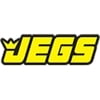| Ratings |
|---|
| Price |
| Brand |
Aluminum Mounting Bracket Kit
JEGS 555-52120 Electric Fan Mounting Bracket Kit Features:
- Fits 13”-16” electric fans with 4-7/8 “ to 9-1/4 “ mounting hole spacing
- Constructed from billet aluminum for great looks and long life
- Adjustable to accommodate most applications
- Includes (2) adjustable flat brackets, (4) “l” mounting brackets with #10-24 studs, (8) #10 x 1/2 in. screws, (4) #10-24 x 5/8 in. carriage bolts, (8) #10 flat washers, and (8) #10-24 nyloc nuts
- Made in USA with high-quality components and assembly
- Fits: 13 in. to 16 in. Electric Pusher or Puller Fans with 4 7/8 in. to 9 1/4 in. Mounting Hole Spacing
- Lightweight 11 (.09074) Gauge 6061-T6 Aluminum
- Adjustable from 15 in. to 24 in. Length
- Will work with Cross Flow and Down Flow Radiators
Includes:
- (2) Adjustable Flat Brackets
- (4) L Mounting Brackets with #10-24 Studs
- (8) #10 x 1/2 in. Screws
- (4) #10-24 x 5/8 in. Carriage Bolts
- (8) #10 Flat Washers
- (8) #10-24 Nyloc Nuts
Specifications:
Motor Vehicles
WARNING: Motor vehicles contain fuel, oils and fluids, battery posts, terminals and related accessories which contain lead and lead compounds and other chemicals known to the State of California to cause cancer, birth defects and other reproductive harm. These chemicals are found in vehicles, vehicle parts and accessories, both new and as replacements. When being serviced, these vehicles generate used oil, waste fluids, grease, fumes and particulates, all known to the State of California to cause cancer, birth defects, and reproductive harm.
Tools:
WARNING: Some dust created by power sanding, sawing, grinding, drilling, and other construction activities contains chemicals known to the State of California to cause cancer and birth defects or other reproductive harm. Some examples of these chemicals are: lead from lead-based paints, crystalline silica from bricks and cement and other masonry products, and arsenic and chromium from chemically treated lumber. Your risk from exposure to these chemicals varies, depending on how often you do this type of work. To reduce your exposure, work in a well-ventilated area and with approved safety equipment, such as dust masks that are specially designed to filter out microscopic particles.
Electrical Cords
WARNING: The wires of these products contain chemicals known to the State of California to cause cancer and birth defects or other reproductive harm. Wash hands after handling.

![Electric Fan Mounting Bracket Kit [Aluminum] Electric Fan Mounting Bracket Kit [Aluminum]](http://www.jegs.com/images/photos/500/555/555-52120.jpg)

